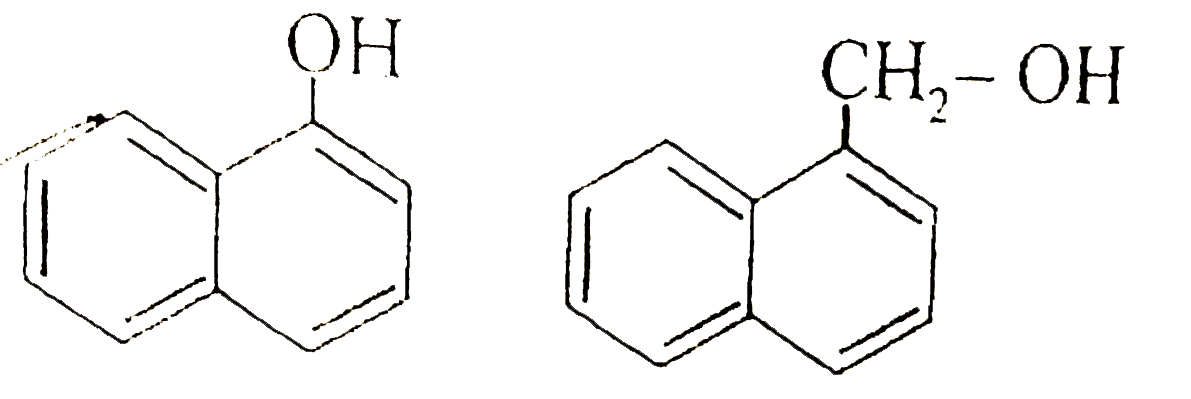Which of the following represent correct pair of homologous ?

MeOH and MeCH2CH2OH


The correct Answer is:B, C
To determine which pairs represent correct homologous series, we need to analyze the given options. Homologous series are groups of organic compounds that differ by a constant unit, typically a -CH2- group, and have similar chemical properties.
1. Identify the Options: We have four pairs of compounds to analyze. Let's denote them as A, B, C, and D.
2. Analyze Option A:
- The first compound is a phenol (with an OH group directly attached to a benzene ring).
- The second compound is a primary alcohol (with an OH group attached to a saturated carbon).
- Conclusion: These two compounds are not homologous because they belong to different functional groups and have different chemical properties.
3. Analyze Option B:
- The first compound is methanol (CH3OH).
- The second compound is ethylene glycol (MECH2CH2OH).
- Conclusion: These compounds can be part of a homologous series. Methanol can be considered the first member, and by adding a -CH2- group, we can derive the next member (ethylene glycol). Thus, this pair is homologous.
4. Analyze Option C:
- The first compound is an ester (HC=OCH2).
- The second compound is another ester (C=OCH2).
- Conclusion: These compounds differ by a -CH2- group and belong to the same functional group (esters). Therefore, this pair is also homologous.
5. Analyze Option D:
- The first compound is a primary amine (CH3CH2NH2).
- The second compound is a secondary amine (CH3CH2NHCH3).
- Conclusion: These compounds are different classes of amines and do not represent a homologous series since they differ by more than just a -CH2- group.
6. Final Conclusion: The correct pairs of homologous series are B and C.
Final Answer:
The correct pairs of homologous series are B and C.
- The first compound is a phenol (with an OH group directly attached to a benzene ring).
- The second compound is a primary alcohol (with an OH group attached to a saturated carbon).
- Conclusion: These two compounds are not homologous because they belong to different functional groups and have different chemical properties.
- The first compound is methanol (CH3OH).
- The second compound is ethylene glycol (MECH2CH2OH).
- Conclusion: These compounds can be part of a homologous series. Methanol can be considered the first member, and by adding a -CH2- group, we can derive the next member (ethylene glycol). Thus, this pair is homologous.
- The first compound is an ester (HC=OCH2).
- The second compound is another ester (C=OCH2).
- Conclusion: These compounds differ by a -CH2- group and belong to the same functional group (esters). Therefore, this pair is also homologous.
- The first compound is a primary amine (CH3CH2NH2).
- The second compound is a secondary amine (CH3CH2NHCH3).
- Conclusion: These compounds are different classes of amines and do not represent a homologous series since they differ by more than just a -CH2- group.
The correct pairs of homologous series are B and C.
Topper's Solved these Questions
- NOMENCLATURE AND CLASSIFICATIONBOOK - GRB PUBLICATIONCHAPTER - NOMENCLATURE AND CLASSIFICATIONEXERCISE - Comprehension 1
3 Videos
- NOMENCLATURE AND CLASSIFICATIONBOOK - GRB PUBLICATIONCHAPTER - NOMENCLATURE AND CLASSIFICATIONEXERCISE - Comprehension 2
3 Videos
- NOMENCLATURE AND CLASSIFICATIONBOOK - GRB PUBLICATIONCHAPTER - NOMENCLATURE AND CLASSIFICATIONEXERCISE - Reasoning Type
10 Videos
- MOLE CONCEPT, STOICHIOMETRY & CONCENTRATION TERMSBOOK - GRB PUBLICATIONCHAPTER - MOLE CONCEPT, STOICHIOMETRY & CONCENTRATION TERMSEXERCISE - Subjective type
145 Videos
- PERIODIC TABLEBOOK - GRB PUBLICATIONCHAPTER - PERIODIC TABLEEXERCISE - Subjective Type
32 Videos
Similar Questions
Knowledge Check
Which of the following represent pair of homologue.
A B
B C
C D
D
Which of the following represents pair of lines?
A2x2+3xy−2y2+5x+5y+3=0B2x2−2y2+5x+5y+3=0C2x2+5xy−2y2+5x+5y+3=0D2x2+3xy−4y2+5x+5y+3=0Which of the following represents the pair of sex chromosomes in men?
AXYBXXCYYDNo option is correct
Which of the following represent phylogenetic homology
View SolutionWhich of the following represents a pair of enantiomes?
View SolutionWhich one of the following is the correct example of homologous organs ?
View SolutionWhich of the following represents pair of equal sets?
View SolutionWhich of the following pairs represents anomers ?
View Solution
